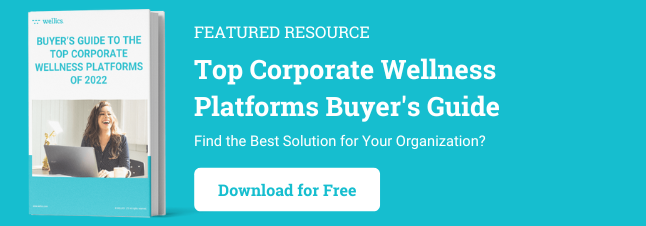Dimitris is the CEO of Wellics. He has spent most of his career in the technology…
Healthier living leads to happier employees and potentially increased workplace productivity.
A wellness program can motivate employees to adopt and maintain behaviors such as weight management, healthy eating, and tobacco cessation.
Wellness programs may also offer employees disease management counseling, preventative screenings, and encouragement and support. They come in countless forms but share a common goal: improving employee health and productivity while reducing healthcare costs.
Employees participating in a wellness program will generally receive a health risk assessment (“HRA”) to assess their potential health risks and set wellness goals.
HR managers are keenly positioned to generate the multi-level leadership needed to achieve these changes. As the “point person” in such endeavors, the HR manager should first identify and engage individuals at all levels and define the wellness budget in an organization.
With the help of a savvy HR manager, your organization can then:
- Provide input for establishing a vision of a healthy organizational culture.
- Develop a systematic plan of action that includes the various tasks that need to be carried out.
- Build a strong business case for a healthy organizational culture.
- Establish a list of criteria for considering organizational strategies.
- Craft a list of proposed strategies based on the collective input of all groups.
- Research the impact of the proposed strategies.
- Develop a list of strategies that meet minimum acceptable criteria.
- Establish a timetable for implementing the strategies.
- Phase in the recommended strategies.
- Develop a method to periodically assess the impact of each strategy and procedure for revision, if necessary.
Building a healthy organizational culture involves the physical work structure and the employees’ perception of that work environment. It becomes apparent that depending on how much you are willing to offer your employees, the cost will vary accordingly.
Corporate Wellness Pricing Models
A wellness platform typically costs between $2 and $10 per employee per month ($24 -$100/ year). Several vendors will offer discounts when opting for an annual plan (vs. a monthly subscription). In specific cases, vendors set a minimum number of users, often around 25. At the same time, it is common for some wellness portal vendors to demand a set-up fee (usually a few thousand dollars).
Typically this includes mobile and web applications that can offer a health risk appraisal, incentive and reward management, online resources, behavior change, team challenges, and the integration of fitness devices. That cost will rarely include gift cards, T-shirts, or other material incentives.
The main points you need to consider around the cost of a wellness program software are:
- Comprehensive offering: This will be a wellness program software that covers the needs of HR and employees alike, from being able to deploy strategies and monitor their execution to assessing their impact and generating detailed reports while driving high employee engagement.
- Features and integrations: Let’s make it simple. You cannot compromise on features. Mobile apps are a must, while seamless integrations with popular wearable devices (Fitbit, Garmin, Samsung, Apple, etc.) must be a prerequisite in selecting corporate wellness software in 2022. All the merrier if the platform provides integrations with popular HRMIS such as Bamboo, Zoho, SAP, etc.
- Support and Training: This is critical to the success of your roll-out efforts as it impacts the overall experience of HR and employees in your organization.
→ Explore the Wellics Platform
Conclusion
A wellness program should not be limited to the conventional gym membership with incentives or the employee teambuilding leagues, nor should it be just boiled down to deploying software tools and apps.
It should be comprehensive, including all the fundamental lifestyle areas of employees. A healthy workplace environment, stress management, sleep, physical activity, and healthy nutritional habits must be part of it.
For a successful and effective wellness program, the leadership in the company must inject a lot of effort and be persistently relentless in building a healthy workforce.
Proactive management of employees’ health is fundamental, and software technology can be an integral part of effectuating behavior and cultural change, but not the panacea.
Originally published March 22, 2022 - 8:17 AM, updated September 12, 2024











